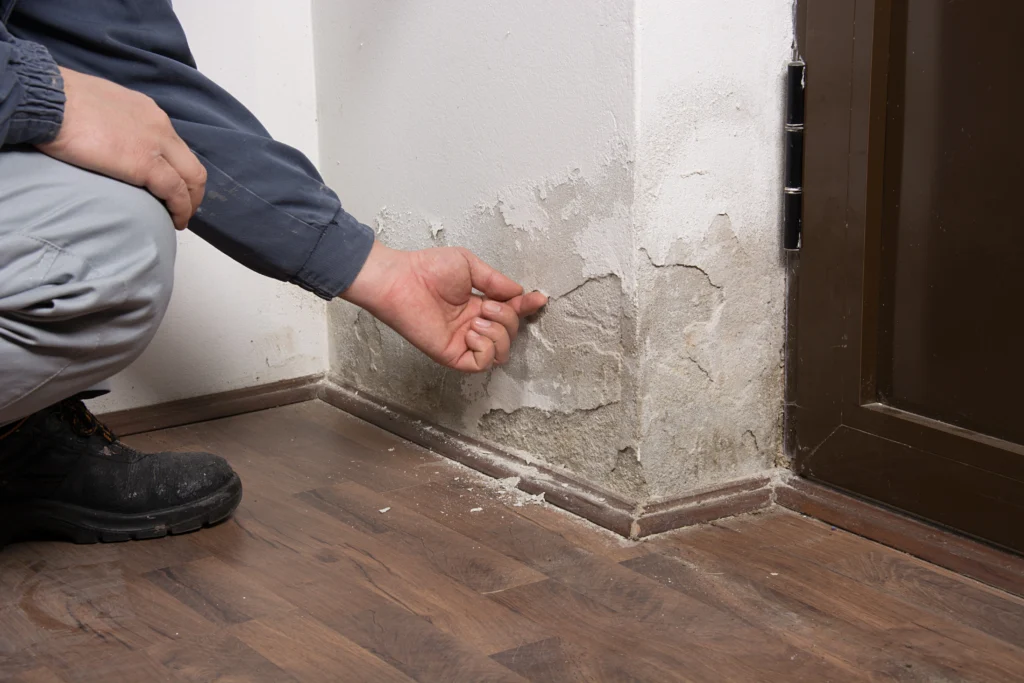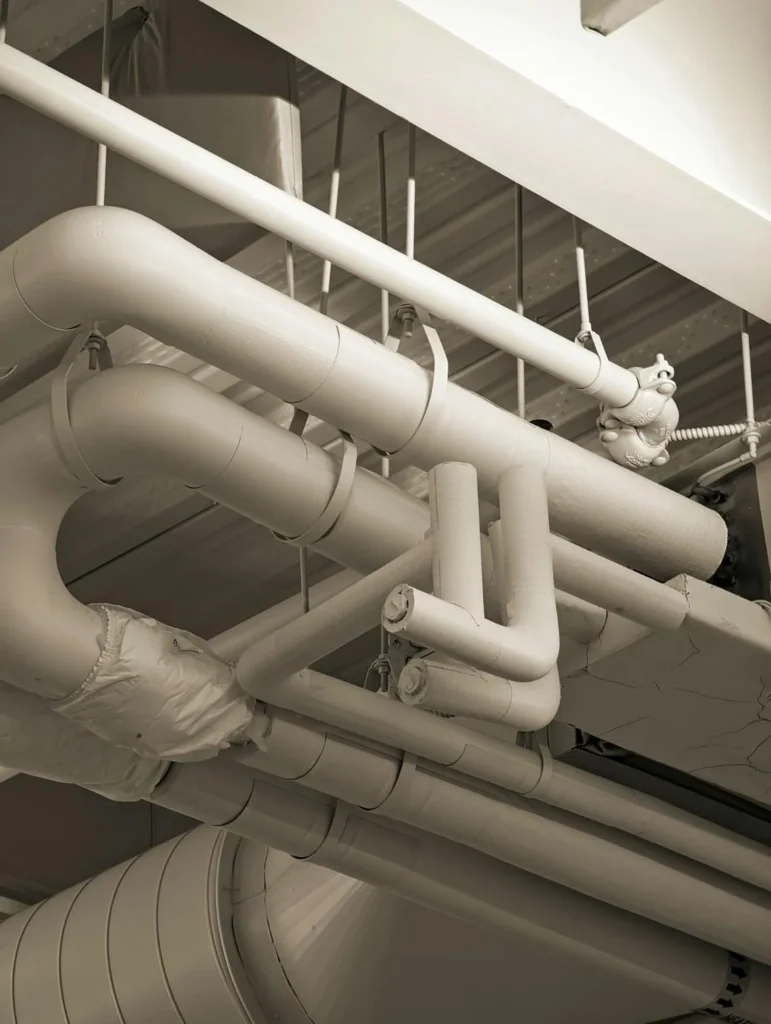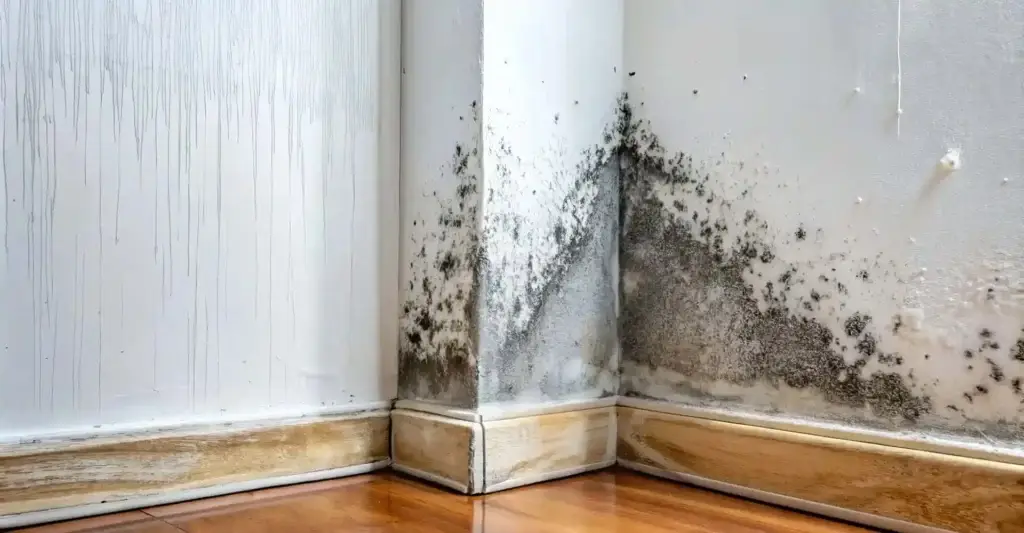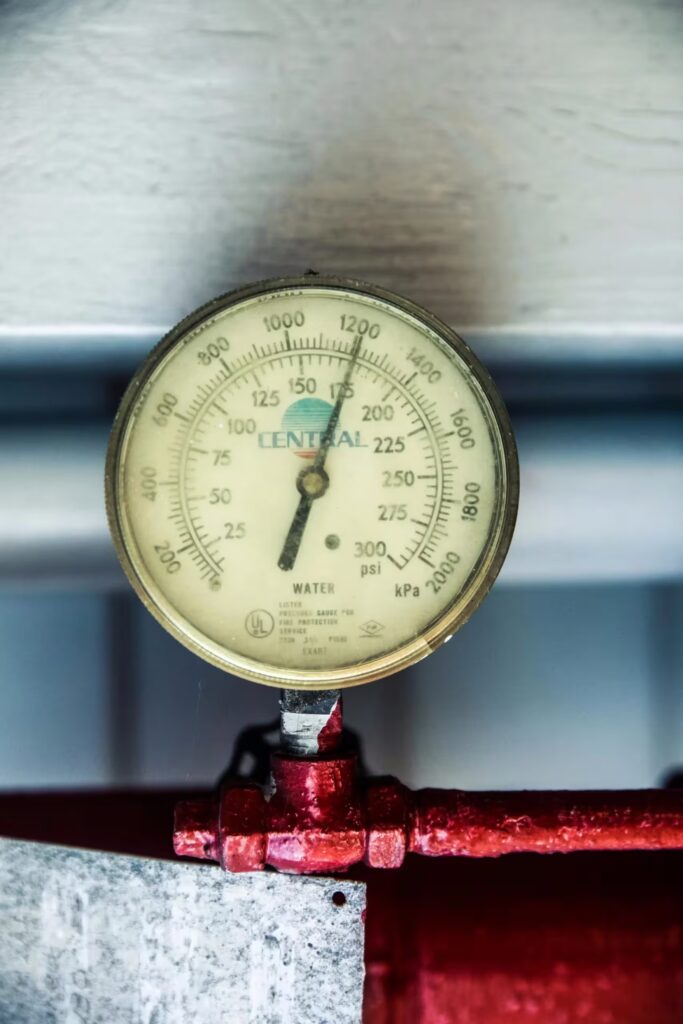Upon discovering damp in a UK property, a professional damp survey is the crucial first step. A surveyor uses specialised equipment like moisture meters and thermal imaging to accurately diagnose the type of damp, be it rising, penetrating, or condensation, and pinpoint its hidden source. This is essential because misdiagnosis leads to ineffective repairs and allows for ongoing structural damage and mould growth. A professional survey provides a detailed report and a clear roadmap for effective remediation, which is far more reliable and safer than a DIY approach.
Skip to:
What are the common signs of damp?
What are the different types of damp?
What a professional damp survey involves
Damp surveys for UK property
The discovery of damp in a property can be a significant cause for concern for both homeowners and commercial landlords across the UK. That tell-tale musty smell, peeling wallpaper, or suspicious dark patches often lead to immediate questions: “What exactly is this damp? Is it serious? How much will it cost to fix? And do I really need a professional damp survey, or can I sort this myself?”.
At Ideal Response, we specialise in comprehensive damp surveys across the UK, providing clarity, accurate diagnosis, and effective solutions for all types of moisture ingress. We understand the anxieties and uncertainties that damp brings. This in-depth guide is designed not just to explain our services, but to answer your most pressing questions, empowering you with the knowledge to protect your property and health from the hidden dangers of damp.
Why do I need a professional damp survey?
You might already suspect damp, so why pay for a survey? A professional damp survey goes far beyond a casual visual inspection. It’s a critical investment for several reasons:
- Accurate diagnosis: Different types of damp (rising, penetrating, condensation) require vastly different solutions. Misdiagnosing the problem can lead to ineffective treatments, wasted money, and ongoing issues. A surveyor uses specialised equipment to pinpoint the exact cause.
- Hidden problems: Damp often hides behind plaster, under floors, or within cavities. A professional survey employs tools like moisture meters, thermal imaging cameras, and boroscopes to detect concealed moisture and its source.
- Preventing structural damage: Persistent damp can compromise the structural integrity of your property over time, leading to rot in timbers, weakening of brickwork, and damage to foundations. Early diagnosis protects your investment.
- Health risks: Damp conditions, especially those leading to mould growth, can trigger or exacerbate respiratory problems, allergies, and other health issues for occupants. A survey identifies these risks.
- Property value & saleability: Damp can significantly devalue a property and deter potential buyers or tenants. A professional report provides peace of mind and can be crucial during property transactions.
- Insurance claims: Many insurance companies will require a professional report detailing the cause and extent of damp before processing a claim.
What are the common signs of damp in a property?
Being able to spot the early signs of damp can save you significant time and money. Look out for:
Musty/earthy smell: This is often one of the first indicators, particularly noticeable in basements, cupboards, or behind furniture.
Tide marks/stains: On walls, especially low down, indicating rising damp. Water stains on ceilings or walls can point to penetrating damp or leaks.
Peeling wallpaper & blistering paint: Dampness prevents wallpaper paste from adhering and causes paint to bubble as moisture tries to escape.
Discolouration/black spots: Dark patches or clusters of black, green, or brown spots are tell-tale signs of mould growth, often caused by condensation or persistent damp.
Decaying skirting boards/timber: Soft, crumbling, or dark timber is a sign of wet rot, which thrives in damp conditions.
Cold walls/surfaces: Damp walls transfer heat less effectively, making affected areas feel noticeably colder to the touch.
Condensation on windows: While often a separate issue, excessive condensation can lead to secondary damp problems.

What types of damp are there, and how do I differentiate them?
Understanding the different types of damp is crucial for effective treatment. A professional damp surveyor will distinguish between these:
Rising damp: This occurs when groundwater rises through capillary action through porous materials (like bricks and mortar) in walls from the ground.
- Signs: Typically confined to the lower parts of walls (up to 1 metre high), tide marks, salt efflorescence (fluffy white deposits), peeling wallpaper, and crumbling plaster. Usually present on ground floor walls.
- Causes: A failed or missing damp proof course (DPC) or a raised ground level bridging the DPC.
Penetrating damp: This is caused by water ingress from outside, moving horizontally through walls or downward from roofs.
- Signs: Can appear anywhere on walls or ceilings, often as random damp patches that grow after rainfall. Crumbling plaster, staining, and mould growth.
- Causes: Defective gutters or downpipes, cracked rendering, porous brickwork, leaky roofs, damaged flashing, blocked cavity walls, or faulty window/door seals.
Condensation damp: This is the most common form of damp in UK homes and occurs when warm, moist air meets a cold surface, turning into liquid water.
- Signs: Black spot mould (often in corners, behind furniture, in bathrooms/kitchens), streaming windows, musty smells, and peeling paint, usually in areas with poor ventilation.
- Causes: High internal humidity (from cooking, showering, drying clothes indoors) combined with inadequate ventilation and/or poor insulation.
How much does a damp survey cost in the UK?
The cost of a professional damp survey in the UK varies, but it’s important to view it as an investment that can save you significant repair costs down the line. Factors influencing the price include:
- Property size: Larger properties or those with multiple affected areas will take longer to survey.
- Severity of damp: If the damp is extensive or difficult to access, the survey might be more complex.
- Location: Prices can vary regionally across the UK.
- Type of survey: A basic visual inspection might be cheaper than a comprehensive invasive survey requiring material samples or advanced equipment.
- Surveyor qualifications/experience: Highly qualified and experienced surveyors may charge more, but their expertise is invaluable.
- Scope of report: The detail and recommendations included in the final report.
While some basic surveys might start from a few hundred pounds, a comprehensive assessment for a larger property or complex issue could be more. Ideal Response provides clear, upfront pricing after an initial discussion about your needs. Always ensure you receive a detailed quote.
What does a professional damp survey involve?
A thorough damp survey is a multi-stage process, typically involving:
- Initial discussion: Understanding your observations, the history of the property, and specific areas of concern.
- External inspection: Checking gutters, downpipes, roofing, rendering, brickwork, ground levels, and drainage for external sources of moisture.
Internal inspection:
- Visual assessment: Looking for visible signs of damp, mould, and timber decay.
- Moisture meter readings: Taking readings on walls, floors, and timbers to identify moisture content.
- Thermal imaging: Using an infrared camera to detect cold spots indicative of moisture or missing insulation.
- Hygrometer readings: Measuring internal humidity levels.
- Non-invasive checks: Examining sub-floor ventilation, cellar conditions, and wall cavities where accessible.
- Invasive checks (if necessary and with permission): In some complex cases, minor drilling to take moisture readings from deeper within the wall or removing a small section of skirting board may be required to confirm diagnosis.
Diagnosis: Based on all gathered data, the surveyor accurately diagnoses the type(s) of damp and its source.
Detailed report: A comprehensive report outlining findings, diagnosis, photographic evidence, and specific, actionable recommendations for remediation.
What happens after a damp survey?
The damp survey isn’t just about identifying the problem; it’s about providing the roadmap to a solution.
- Comprehensive report: You’ll receive a detailed report outlining the findings, including the type(s) of damp, the likely cause(s), photographic evidence, and precise recommendations for remediation. This report is crucial for insurance claims or property transactions.
- Tailored approach: Based on the diagnosis, recommendations could include:
- For rising damp: Installation or repair of a damp proof course (DPC), re-plastering with specialist damp-proof renders.
- For penetrating damp: Repairing external defects (gutters, roofs, rendering), re-pointing brickwork, or applying waterproof renders.
- For condensation: Improving ventilation (e.g. extractor fans, PIV systems), increasing insulation, and advising on lifestyle changes.
- Quotation for Works: Ideal Response can provide a transparent quotation for the recommended remediation works, allowing you to proceed with confidence.
Can I do a DIY damp check?
You can certainly do an initial visual check yourself, and it’s always good to be aware of the signs. However, for anything beyond very obvious surface condensation, a DIY approach has significant limitations:
- Pros of DIY check: Free, quick, helps you spot obvious problems.
- Cons of DIY Check:
- Misdiagnosis: You might mistake rising damp for penetrating damp, leading to the wrong (and ineffective) treatment.
- Hidden moisture: Without professional equipment, you’ll miss moisture behind walls or under floors which lead to recurring issues and mould.
- Incomplete solutions: You might only treat the symptom, not the root cause.
- Safety: Dealing with mould or potential structural issues requires expertise.
For accurate diagnosis and lasting solutions, a professional damp survey is always recommended.
How long does a damp survey take?
The duration of a damp survey depends on the property size and complexity of the issue but typically ranges from 1 to 3 hours. A comprehensive report usually follows within a few working days.
When choosing a damp surveyor, look for:
- Experience: Years of practical experience in diagnosing and treating damp.
- Qualifications: Ideally, a surveyor should hold certifications from recognised bodies such as the Property Care Association (PCA) – specifically a CSRT (Certified Surveyor in Remedial Treatments) or CSSW (Certified Surveyor in Structural Waterproofing). These indicate a high level of expertise and adherence to industry standards.
Conclusion: Protect your health and property
Damp isn’t just an aesthetic problem; it’s a threat to your property’s integrity and the health of its occupants. By understanding the signs, the types, and the benefits of a professional damp survey, you’re well-equipped to tackle this common UK property issue.
If you suspect damp in your home or commercial property, don’t leave it to chance. Ideal Response offers thorough, accurate, and professional damp surveys across the UK, followed by effective remediation strategies.
UK Damp survey: Frequently asked questions
What are the common signs of damp in a property?
The common signs of damp include a musty/earthy smell, peeling wallpaper or blistering paint, tide marks or water stains on walls, and the presence of black spot mould in corners or behind furniture. You may also notice decaying skirting boards, cold walls, and excessive condensation on windows.
Why do I need a professional damp survey?
A professional damp survey is a critical investment because it provides an accurate diagnosis of the damp’s type and source using specialised equipment like moisture meters and thermal imaging. This prevents misdiagnosis, protects your property’s structural integrity, and identifies health risks from hidden mould. A professional report is also often required for insurance claims or property sales.
What are the different types of damp, and what causes them?
There are three main types of damp:
-
Rising damp: Caused by groundwater rising through walls due to a failed damp proof course (DPC). Signs are low-level damp, tide marks, and crumbling plaster.
-
Penetrating damp: Caused by water entering from outside (e.g., leaky roofs, cracked rendering). Signs are random damp patches that often appear after rainfall.
-
Condensation damp: The most common type, caused by warm, moist air meeting cold surfaces. Signs are black spot mould and streaming windows, especially in unventilated areas.
How much does a damp survey cost in the UK?
The cost of a professional damp survey in the UK is variable, typically starting from a few hundred pounds. The final price depends on factors such as property size, the severity and complexity of the damp, and the specific qualifications of the surveyor. It is an investment that can save you significant repair costs in the long run.
What does a professional damp survey involve?
A professional damp survey involves a thorough multi-stage process:
-
Initial Discussion: To understand your concerns.
-
External & Internal Inspection: A visual check of the property.
-
Specialised Readings: Use of moisture meters, thermal imaging, and hygrometers to detect hidden moisture.
-
Diagnosis: An accurate diagnosis of the damp’s type and source.
-
Detailed Report: A comprehensive report with findings, photographic evidence, and actionable remediation recommendations.
How can I get rid of damp and prevent it from returning?
The solution depends on the type of damp:
-
For rising damp: Installation of a new damp proof course (DPC) and specialist re-plastering.
-
For penetrating damp: Repairing the external defect (e.g., gutters, rendering, or roof leaks).
-
For condensation: Improving ventilation and insulation, often with extractor fans or positive input ventilation (PIV) systems.
What qualifications should I look for in a damp surveyor?
When choosing a damp surveyor, you should look for someone with practical experience and relevant qualifications. The gold standard is a surveyor certified by the Property Care Association (PCA), specifically holding a CSRT (Certified Surveyor in Remedial Treatments) or CSSW (Certified Surveyor in Structural Waterproofing) qualification.

Kayleigh Owen - Technical Account Manager
With years of dedicated experience in the disaster recovery industry, Kayleigh Owen brings a precise and insightful approach to every project. Holding a BSc Hons Degree, Kayleigh specialises in construction and major loss, expertly navigating the complexities of large-scale fire and flood events. Having spent her entire industry career at Ideal Response, she has honed a deep understanding of what it takes to restore properties and lives with efficiency and empathy. Kayleigh believes that meticulous planning and clear communication are the cornerstones of transforming disaster into recovery, ensuring every client receives not just a solution, but true peace of mind.





















